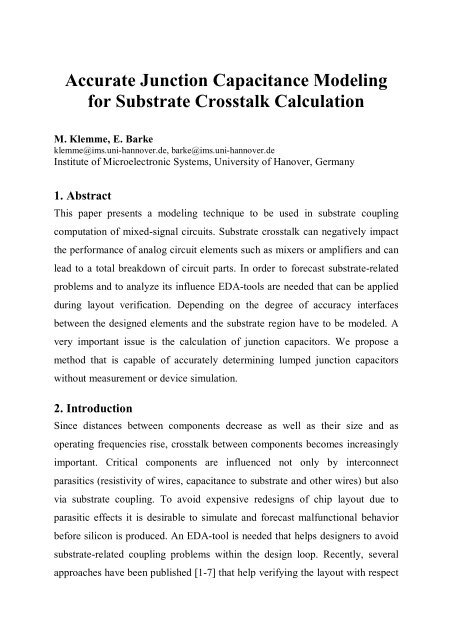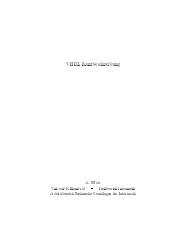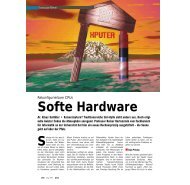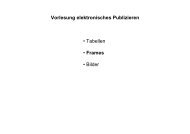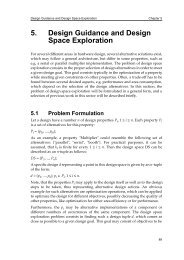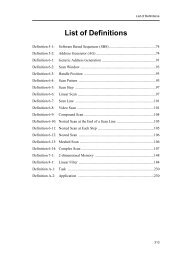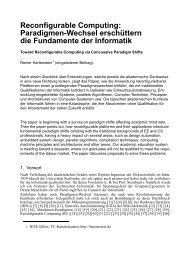Accurate Junction Capacitance Modeling for Substrate Crosstalk ...
Accurate Junction Capacitance Modeling for Substrate Crosstalk ...
Accurate Junction Capacitance Modeling for Substrate Crosstalk ...
Create successful ePaper yourself
Turn your PDF publications into a flip-book with our unique Google optimized e-Paper software.
<strong>Accurate</strong> <strong>Junction</strong> <strong>Capacitance</strong> <strong>Modeling</strong><br />
<strong>for</strong> <strong>Substrate</strong> <strong>Crosstalk</strong> Calculation<br />
M. Klemme, E. Barke<br />
klemme@ims.uni-hannover.de, barke@ims.uni-hannover.de<br />
Institute of Microelectronic Systems, University of Hanover, Germany<br />
1. Abstract<br />
This paper presents a modeling technique to be used in substrate coupling<br />
computation of mixed-signal circuits. <strong>Substrate</strong> crosstalk can negatively impact<br />
the per<strong>for</strong>mance of analog circuit elements such as mixers or amplifiers and can<br />
lead to a total breakdown of circuit parts. In order to <strong>for</strong>ecast substrate-related<br />
problems and to analyze its influence EDA-tools are needed that can be applied<br />
during layout verification. Depending on the degree of accuracy interfaces<br />
between the designed elements and the substrate region have to be modeled. A<br />
very important issue is the calculation of junction capacitors. We propose a<br />
method that is capable of accurately determining lumped junction capacitors<br />
without measurement or device simulation.<br />
2. Introduction<br />
Since distances between components decrease as well as their size and as<br />
operating frequencies rise, crosstalk between components becomes increasingly<br />
important. Critical components are influenced not only by interconnect<br />
parasitics (resistivity of wires, capacitance to substrate and other wires) but also<br />
via substrate coupling. To avoid expensive redesigns of chip layout due to<br />
parasitic effects it is desirable to simulate and <strong>for</strong>ecast malfunctional behavior<br />
be<strong>for</strong>e silicon is produced. An EDA-tool is needed that helps designers to avoid<br />
substrate-related coupling problems within the design loop. Recently, several<br />
approaches have been published [1-7] that help verifying the layout with respect
to the underlying substrate and its physical properties. Some of those approaches<br />
work with a 2,5-dimensional discretization of the substrate, others apply<br />
boundary element methods to a conducting semiplane. All of them derive a<br />
network description using lumped elements to represent the substrate region.<br />
The problem ahead is to accurately connect the substrate network to the network<br />
of the designed elements.<br />
In CMOS circuits, <strong>for</strong> instance, capacitors model the depletion capacitance from<br />
the wells to substrate. It is necessary to divide the overall capacitance into<br />
smaller fractions. Fig. 1 shows an example of an arbitrarily shaped well and a<br />
possible arrangement of capacitors.<br />
y<br />
x<br />
Well<br />
z<br />
x<br />
Well<br />
Fig. 1: Capacitor fractions of a well<br />
Fig. 2 shows a fragment of a sidewall and the surfaces of the discretization. Each<br />
surface of the sidewall represents the area of a partial junction capacitor.<br />
z<br />
y<br />
x<br />
Fig. 2: Sidewall discretization<br />
Normally a plate capacitor model is used to determine the value of each<br />
capacitor. As we found out (see results) this assumption holds <strong>for</strong> the bottom of<br />
the well but does not hold <strong>for</strong> the sidewalls.
3. Basic Formulas<br />
The well depletion-layer capacitor is determined under the assumptions that<br />
• the electric field outside the space-charge region equals zero,<br />
• the overall charge of the space-charge region equals zero,<br />
• the electric field is continual,<br />
• the doping concentration changes abruptly at the junction.<br />
Under these circumstances the width of the space-charge region is<br />
l<br />
s<br />
=<br />
2ε<br />
0 ε<br />
q<br />
r<br />
⎛<br />
1<br />
1<br />
( U D − U ) ⎜ +<br />
⎟ ⎝ N A N D ⎠<br />
⎞<br />
(1)<br />
with q being the electrical charge, N A and N D the mean impurity concentrations<br />
on opposite sides of the junction, U D the diffusion voltage and U the actual<br />
voltage drop between the two sides. The profile is assumed to be Gaussian so<br />
that in the vicinity of the junction the doping concentration is given by<br />
N<br />
z ⎞ ⎤<br />
( z′ ) = N ⋅ exp − −1⎥ ⎦<br />
B<br />
⎢ ⎣<br />
⎡<br />
LD<br />
λ =<br />
ln<br />
N<br />
with N0<br />
(3)<br />
B<br />
N B stands <strong>for</strong> the substrate doping concentration, L D is the diffusion length, N 0<br />
denotes the surface concentration. The usual way to determine a fraction of the<br />
overall capacitance is to assume a plate capacitor and calculate the capacitance<br />
as<br />
ε r A<br />
C 0 ε<br />
=<br />
ls<br />
⎛ ′<br />
⎜ ⎟<br />
⎝ λ ⎠<br />
where A is the appropriate face area <strong>for</strong> a part of the well (side or bottom). The<br />
comparison between simulation and results (see below) shows that in this way<br />
the sidewall capacitors are highly underestimated. There<strong>for</strong>e, we propose to use<br />
the cylindrical capacitor model and the spherical capacitor model, respectively.<br />
Their capacitances are determined as<br />
(2)<br />
(4)
with r 1 denoting the inner and r 2 the outer radius and l the length of the<br />
cylindrical capacitor;<br />
2π<br />
lε<br />
0ε<br />
r<br />
Ccyl<br />
= .<br />
⎛ r2<br />
⎞<br />
ln<br />
⎜<br />
⎟<br />
⎝ r1<br />
⎠<br />
4πε<br />
0ε<br />
r r1<br />
r2<br />
Csph<br />
=<br />
r2<br />
− r1<br />
with r 1 being the inner and r 2 the outer radius of the spherical capacitor. It can be<br />
seen from Fig. 1 and Fig. 3 that three different regions exist:<br />
1. a planar region <strong>for</strong> the bottom<br />
2. a cylindric region <strong>for</strong> the sidewalls<br />
3. a spheric region <strong>for</strong> the corners<br />
(5)<br />
(6)<br />
4. Sidewall calculation<br />
Fig. 3: Different regions<br />
Cylindric region<br />
Planar region<br />
Spheric region<br />
Due to the lateral diffusion length o, with o≠d the shape of the sidewalls is<br />
elliptical instead of cylindrical.<br />
o<br />
Mask<br />
d<br />
<strong>Substrate</strong><br />
Fig. 4: Diffused region<br />
Fig. 5 shows a cut through a sidewall. F1 through F5 are five surfaces that result<br />
in five junction capacitors, that may be combined later on. First the height h and<br />
the width w are determined <strong>for</strong> each surface. To do so, the range of the quarterellipse<br />
is divided into equal parts depending on the maximal structure size. The
equation <strong>for</strong> the ellipse (7) and the equation <strong>for</strong> the cutting line (8) lead to the<br />
points necessary <strong>for</strong> the determination of the surfaces.<br />
o<br />
ϕ<br />
F5<br />
F4<br />
F5<br />
F4<br />
d<br />
F3<br />
F3<br />
z’<br />
h<br />
F2<br />
F1<br />
F2<br />
F1<br />
x’<br />
w<br />
Fig. 5: Cut through a sidewall<br />
( z′<br />
− d )<br />
2<br />
x′<br />
+ = 1<br />
2 2<br />
o d<br />
x z′<br />
+ = 1<br />
⎛ π level ⎞ d<br />
d ⋅ tan<br />
⎜ ⋅<br />
2 _<br />
⎟<br />
⎝ n lev ⎠<br />
Level stands <strong>for</strong> the actual level and n_lev <strong>for</strong> the number of levels (in Fig. 4<br />
level=5). Solving the equations <strong>for</strong> x’ and z’ leads to the desired intersection<br />
points. This way h and w <strong>for</strong> the upper and <strong>for</strong> the lower point and the center of<br />
gravity can then be determined. With the doping concentrations of the center of<br />
gravity (Fig. 6) the junction capacitor C F <strong>for</strong> the surface fraction F is determined<br />
(7)<br />
(8)<br />
using the mean radius r m<br />
r m = rA<br />
* rB<br />
(9)<br />
x<br />
C<br />
F<br />
ε 0ε<br />
rl<br />
ϕ A − ϕ<br />
=<br />
⎛ r + ⎞<br />
⎜<br />
m ls<br />
ln<br />
r<br />
⎟ ⎝ m ⎠<br />
r<br />
ϕ A<br />
A<br />
r m <<br />
r B<br />
ϕ * *<br />
B<br />
z r A r B<br />
B<br />
center of gravity<br />
(10)<br />
Fig. 6: Approximating the elliptic shape
5. Corner calculation<br />
At the corners a spherical approach applies (Fig. 3a). As the corners always have<br />
the surface of one eighth of the surface of a sphere, we can calculate the<br />
capacitance of one corner as<br />
1 4π ε( rm<br />
+ ls<br />
) rm<br />
Ccorner<br />
= ⋅<br />
(11)<br />
8<br />
If the surface is divided into smaller fractions it is possible to divide the corner<br />
capacitor into smaller fractions, according to the area of the surface fractions<br />
related to the surface of the whole corner.<br />
ls<br />
x<br />
z<br />
y<br />
6. Experimental Results<br />
Fig. 7: Corner of a well<br />
The algorithm has been applied to the calculation of a junction capacitor C j0 with<br />
voltage U=0V. We used the algorithm with three examples. Common to all of<br />
them is a p-doped layer within an n-doped epitaxial layer. The implantation<br />
layer areas are depicted in Fig. 8.<br />
Fig. 8 shows two filled areas and one ring-shaped area. D1 and D2 represent two<br />
different processes. The concentration of the epitaxial layer N B , the position of<br />
the pn-junction x j and the surface-concentration N 0 can be extracted from doping<br />
profiles and are given in Tab. 1.
186<br />
D1-Area<br />
36<br />
186<br />
18<br />
186<br />
D2-Area<br />
2<br />
21<br />
D2-Ring<br />
5<br />
Fig. 8: Examples (all measures in µm)<br />
N B [cm -3 ] x j [µm] N 0 [cm -3 ]<br />
D1 3.3E+15 0.56 3.8E+18<br />
D2 3.3E+15 0.74 2.5E+19<br />
Tab. 1: Physical properties of processes<br />
In order to compare measured and calculated results it is necessary to divide the<br />
measured pn-junction capacitors into sidewall and bottom fractions. There<strong>for</strong>e,<br />
equation (12) has to be applied to the measured results.<br />
C j 0 = A ⋅ area + B ⋅ periphery<br />
(12)<br />
In order to get factors A and B a bunch of C(V)-measurements are per<strong>for</strong>med<br />
with different geometries with varying periphery-to-area ratios. Taking into<br />
account all the 0V-values it is possible to separate the two parts using an easy<br />
fitting.<br />
The following table and diagrams show comparisons between measured and<br />
simulated values. “Old way” is an algorithm working on the same discretization<br />
as “New Way”, however, all surface capacitors are calculated with the platecapacitor<br />
model. The table and the diagram also show three columns <strong>for</strong> each<br />
approach and the measurements, respectively. One is <strong>for</strong> the bottom part, one <strong>for</strong><br />
the whole sidewall part and one <strong>for</strong> the overall junction capacitor. Tab. 2
demonstrates the results <strong>for</strong> the examples called “D1-Area”, “D2-Area” and<br />
“D2-Ring” (see Fig. 8).<br />
D1-Area Bottom [pF] Sides [pF] Total [pF]<br />
Old way 1,2036 0,0744 1,2780<br />
New way 1,2021 0,1461 1,3482<br />
Measured 1,1800 0,1540 1,3340<br />
D2-Area Bottom [pF] Sides [pF] Total [pF]<br />
Old way 6,5903 0,1608 6,7511<br />
New way 6,5904 0,2327 6,8231<br />
Measured 6,6400 0,2450 6,8850<br />
D2-Ring Bottom [pF] Sides [pF] Total [pF]<br />
Old way 0,0339 0,0286 0,0625<br />
New way 0,0341 0,0421 0,0762<br />
Measured 0,0349 0,0441 0,0790<br />
Tab. 2: Comparisons <strong>for</strong> example “D1-Area, D2-Area, D2-Ring”<br />
As to be seen in Tab. 2 the main part of the total junction capacitor is <strong>for</strong>med by<br />
the bottom portion <strong>for</strong> D1-Area and D2-Area. In the case of D2-Ring the<br />
sidewall part is even larger than the portion of the bottom part. The calculation<br />
with the plate-capacitor-method leads to results which are much too small<br />
compared to the measured values.<br />
To emphasize the main differences Fig. 9, 10 and 11 show the relative error with<br />
the measured values as a reference. For the sidewall capacitors the deviation lies<br />
between 30% and 50% <strong>for</strong> the old method and under 5% <strong>for</strong> the new approach.<br />
The total capacitor of the ring structure was determined with a deviation of<br />
about 20% with the old method and a deviation of about 5% with the new<br />
method.
D1-Area (Rel. Error)<br />
60,0000<br />
50,0000<br />
40,0000<br />
30,0000<br />
20,0000<br />
10,0000<br />
0,0000<br />
Old wa y<br />
New way<br />
Bot t om<br />
S ides<br />
Tot al<br />
Fig. 9: Relative Error <strong>for</strong> D1-Area<br />
D2-Area (Rel. Error)<br />
40,0000<br />
30,0000<br />
20,0000<br />
10,0000<br />
Bot t om<br />
S ide s<br />
Tot a l<br />
0,0000<br />
Old way<br />
New wa y<br />
Fig. 10: Relative Error <strong>for</strong> D2-Area<br />
D2-Ring (Rel. Error)<br />
40,0000<br />
30,0000<br />
20,0000<br />
10,0000<br />
Bottom<br />
Sides<br />
Total<br />
0,0000<br />
Old way<br />
New way<br />
Fig. 11: Relative Error <strong>for</strong> D2-Ring
7. Conclusions<br />
<strong>Substrate</strong> coupling problems are a challenge <strong>for</strong> mixed-signal circuit designs. It<br />
is necessary to <strong>for</strong>esee possible problems and to analyze the circuit behavior<br />
be<strong>for</strong>e silicon is processed. There<strong>for</strong>e, EDA-tools are needed that try to map<br />
physical properties into circuit elements. An important issue is the calculation of<br />
junction capacitors connecting circuit elements to the substrate. In this paper we<br />
presented a procedure to accurately determine junction capacitors without the<br />
necessity of device-level simulations or measurements.<br />
8. Acknowledgement<br />
This work has been funded by the German Ministry of Research (BMBF) in the<br />
project “PARASITICS” (FKZ: 01 M 3034). We are grateful <strong>for</strong> the<br />
collaboration with Philips Semiconductors, Hamburg, Germany.<br />
9. References<br />
[1] Wemple, I., Yang, A.T., Integrated Circuit <strong>Substrate</strong> Coupling Models Based on Voronoi<br />
Tessellation, IEEE Transactions on Computer-Aided Design of Integrated Circuits and<br />
Systems, Vol. 14, N°12, Dec. 1995, pp. 1459-1468<br />
[2] Verghese, N.K., Allstot, D.J., Computer Aided Design Considerations <strong>for</strong> Mixed-Signal<br />
Coupling in RF Integrated Circuits, IEEE Journal of Solid-State Circuits, Vol. 33, N°. 3,<br />
Mar. 1998, pp. 314-323<br />
[3] Smedes, T., van der Meijs, N.P., van Genderen, A.J., Extraction of Circuit Models <strong>for</strong><br />
<strong>Substrate</strong> <strong>Crosstalk</strong>, Proceedings of Design Automation Conference 1995, pp. 199-206<br />
[4] Gharpurey, R., Meyer, R.G., <strong>Modeling</strong> and Analysis of <strong>Substrate</strong> Coupling in Integrated<br />
Circuits, IEEE Journal of Solid State Circuits, Vol. 31, pp. 344-353, Mar. 1996<br />
[5] Clement, F.J.R.., Zysman, E., Kayal, M., Declercq, M., Layout Inspection Tool<br />
Dedicated to the Parasitic Coupling Effects through the substrate of Integrated Circuits,<br />
Proceedings of PATMOS 1995, pp. 267-276<br />
[6] Stanisic, B.R., Verghese, N.K., Rutenbar, R., Carley, L.R., Allstot, D.J., Adressing<br />
<strong>Substrate</strong> Coupling in Mixed Mode ICs: Simulation and Power Distribution Synthesis,<br />
IEEE Jounal of Solid-State Circuits, Vol. 29, N° 3, 1994, pp. 226-238<br />
[7] Hegedus, S.S., Parasitic Isolation PNP Devices and Their Effect on NPN Saturation<br />
Delay, Design Automation Conference 1980, pp. 107-111


